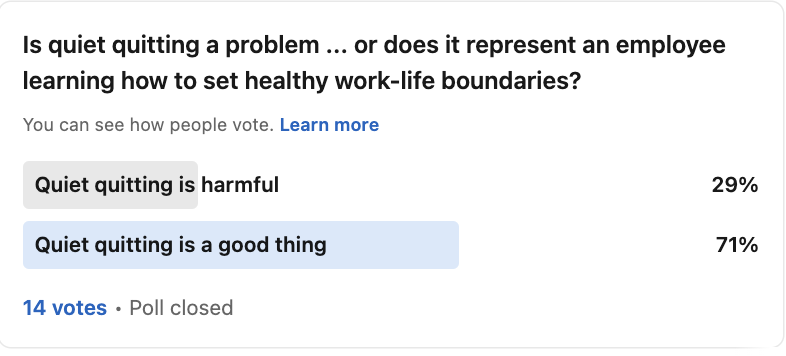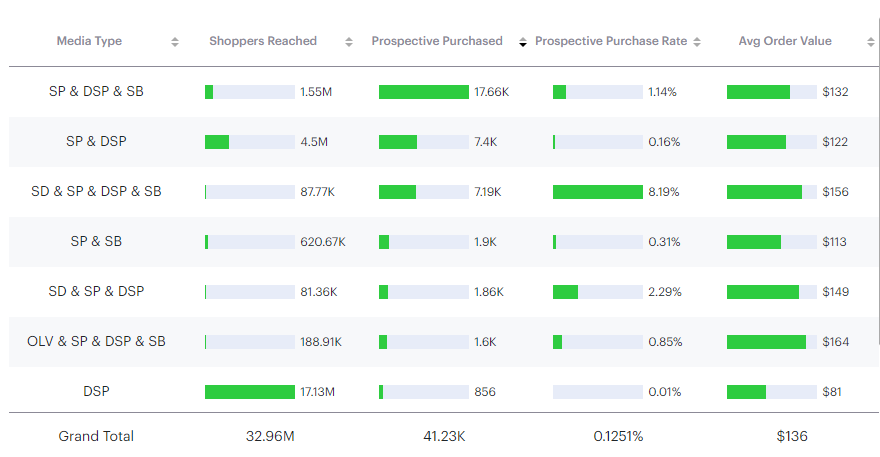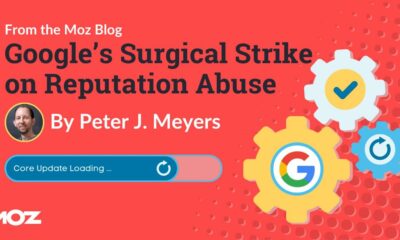MARKETING
Quiet Quitting vs. Setting Healthy Boundaries: Where’s The Line?

In the summer of 2022, we first started hearing buzz around a new term: “Quiet quitting“.
Quiet quitting is a term that essentially means an employee who does the core responsibilities of their role, but doesn’t go above-and-beyond for their company.
I think it‘s safe to say we’ve all met quiet quitters throughout our careers — heck, most of us have been quiet quitters during times when we felt less engaged by our work, and opted for the out-by-five approach rather than staying late to pursue projects outside our scope.
There are parts of the quiet quitting approach that I believe are fundamentally healthy … but there are other aspects that hint at employees who feel unengaged, unmotivated, or unsupported in their roles.
So I‘d like to revisit the concept of quiet quitting and figure out why roughly 30% of full-time employees say they’re quiet quitting in 2024 — and whether that’s actually a bad thing.
What is quiet quitting?
Quiet quitting is a term that took off on TikTok in a video by content creator Zaiad Khan.
In the video, which currently has 3.5 million views, the Tiktoker explains what quiet quitting is: A rejection of hustle culture and a reclaiming of work-life balance.
Shortly after, other TikTok users shared their thoughts and experiences with quiet quitting – the hashtag now gaining 97.6 million total video views.
So while the term includes the word “quitting,” it actually has nothing to do with it.
Quiet quitting involves completing your work responsibilities without going above and beyond. This looks like logging out at 5 p.m., not seeking additional tasks or projects, and taking regular time off.
For some quiet quitters, it’s a form of rebellion. For others, it’s an odd term to describe something they’ve done for decades.
How many employees are quiet quitting in 2024?
HubSpot Blog Research found one in three full-time employees say they’re actively quiet quitting in 2024.
Here’s how this breaks down by generation:
- 32% of full-time Gen Z
- 37% of full-time millennials
- 35% of full-time Gen X
What‘s more interesting, though, is the respondent’s viewpoint on what quiet quitting actually means: Over half (55%) of full-time employees think quiet quitting is equivalent to setting healthy boundaries at work, while 45% say quiet quitting reflects an employee’s work ethic.
That’s about an equal, 50-50 split.
So I took to LinkedIn and sent out a poll: Do most people think quiet quitting is a bad thing … Or do they think it’s healthy?

The Results Are In Favor of Quiet Quitting … So What Are The Benefits of Quiet Quitting?
A whopping 71% of the respondents on my LinkedIn poll stated that quiet quitting is a good thing.
To be clear: Quiet quitting, a term originally coined by Zaiad Khan in a TikTok video with 3.5 million views, initially began as a reclamation of work-life balance, and a rejection of hustle culture.
As Khan puts in his video: “Work is not your life. Your worth is not defined by your productive output.”
Those in favor of quiet quitting believe that it can help an employee establish boundaries around work, while ensuring they aren’t taken advantage of by their employer.
In other words: Why should an employee stay late to work on “extra” projects beyond their current scope, if they aren’t feeling valued or fulfilled in their role otherwise?
I can see the argument. Many employees are feeling burnout from being required to consistently overachieve. Our culture often emphasizes productivity at all costs – be it mental, physical, or emotional health. (There’s actually a word for this: Toxic productivity.)
HubSpot’s most recent 2024 Consumer Trends report found that the top four reasons employees are considering leaving their jobs in 2024 are:
- Pay is not competitive enough (38%)
- Wanting to switch career paths (24%)
- Lack of a sense of purpose in their work (23%)
- Burnout (20%)
And, to some extent, all of these reasons point back to the benefits of quiet quitting. If you‘re not feeling fulfilled or finding purpose in your role, if you’re not getting paid enough, or if you’re feeling overworked and underaprpeciated … Why should you continue to go above-and-beyond for your employer?
I’m all for setting work-life boundaries and finding your worth outside the productivity hampster wheel.
But hear me out: Is quiet quitting really the healthiest way to do it? Or is quiet quitting just a reflection of an unengaged, unfulfilled employee?
Quiet Quitting Suggests a More Insiduous Problem
A couple of years ago, I was a quiet quitter myself – at a chocolate store.
It was my first high school job, and I didn‘t like my manager. I felt she didn’t respect me enough to abide by my work preferences when it came to my work hours, and she made jokes about my age in front of customers, which embarrassed me.
So what did I do? The bare minimum, of course.
I didn‘t stay late to help her wrap Easter baskets; I didn’t raise my hand when she asked who could pick up an extra Saturday shift; and at six p.m. on the dot, whether I was with a customer or not, I beelined it for the exit.
As silly as this example is (I get it – it was a high school, part-time job), I use it to suggest that quiet quitting isn’t always about achieving more work-life balance, or setting healthy boundaries.
A lot of times, it‘s a miserable experience, and it occurs because an employee doesn’t feel engaged or motivated.
The dream for most employees is to want to go above-and-beyond for their employer. Quiet quitting usually isn‘t an employee’s first choice: Instead, it‘s the result of months or years of burnout where they’ve been unsupported and underappreciated.
In his article, “What’s New About Quiet Quitting (and What’s Not)“, J. Richard Johnson, Ph.D., writes: ”If a worker enjoys his or her job, he or she will supply more — possibly far more — than the bare minimum … Consider as examples the work of a professional surfer or musician. The surfer and the musician get intrinsic joy — gratification — from their work regardless of whether they are paid.”
Simply put: Your employees won’t feel compelled to quietly quit if they feel engaged. The two are at odds.
At HubSpot, I‘ve always felt compelled to own projects outside my role because I know it’s the fastest way to create a career I‘m excited by — and because I trust my employer to reward my hard work. I’ve also felt empowered to work extra hours (at times) because I’ve been too engaged to shut my laptop down.
Why aren‘t I quietly quitting at HubSpot? Because I love my job, I feel appreciated and supported by my manager, and I feel like I’m making a difference. And I trust that my employer has my best interests at heart: Including allowing me to sign off when I’m finished, and never expecting me to give 110% if I only have 70% in the tank.
That‘s empathy, and it’s likely the key to reversing the quiet quitting trend.
How Companies Should Address Quiet Quitting
In an NPR article, critics of this term say that quiet quitting is a misnomer for setting boundaries at work and having a healthy work-life balance.
They also argue that this term highlights how many companies exploit employees and set an expectation of overperformance without adequate compensation.
With this in mind, instead of seeing quiet quitting as a trend that’s harming the workplace, employers should see it as an opportunity to improve their workplace culture.
The fact is: Employees are only “quiet quitting” as a result of a poor workplace environment – and there’s data to support this.
Invest In Good Management
A workplace study by HBR states that quiet quitting is a reflection of “bad bosses” rather than employees’ unwillingness to go the extra mile.
Their researchers found that managers who ranked highest in balancing business needs with employees’ needs had the highest percentage of employees willing to go the extra mile — 62% to be exact with only 3% quiet quitting.
This is a stark contrast to the managers who ranked the lowest in the category only having 20% of their employees willing to go the extra mile and 14% quiet quitting.
An employee who receives adequate support from their manager, is given growth opportunities, and is rewarded for their work will be motivated to perform at the highest level.
It’s up to employers to create the environment in which that happens. It starts with setting boundaries surrounding work hours – this can look like a no-contact policy around out-of-office times.
Management training is also important as that will likely have the strongest impact on the employee. Training on growth coaching, skill development, and pay transparency will help toward building trust with employees and promoting a positive work life.
In addition, set quarterly career chats between managers and their direct reports to discuss areas of interest and focus, current or expected challenges, and more. The more engagement managers build with their teams, the lower the likelihood of quiet quitting.
Encourage Recognition as a Remedy
However, to effectively tackle the problem of quiet quitting, we need to address its roots. When work dissatisfaction affects morale, recognition emerges as a remedy. In environments where recognition is part of the culture, quiet quitting doesn’t thrive because employees are consistently affirmed and reminded of their value.
When employees feel seen and appreciated, it transforms their perception of their work. They become more engaged, form closer bonds with their colleagues, and are less prone to stress and burnout. When employees believe they’re recognized, they are 2.7x more likely to be highly engaged.
So what does effective recognition look like? Shanyu Kates, a Data Analyst on HubSpot’s People Analytics team, told me her team has instituted “High Five Fridays”, a weekly initiative that encourages managers and ICs to give shout-outs via an automated Slackbot in the team channel. This practice is a simple yet powerful tool to reinforce appreciation and combat the underlying causes of quiet quitting.
In most cases, a quiet quitter is simply an employee who doesn’t have the right support. Once you offer what they need, you’ll have an engaged performer on your hands.
How Employees Should Address Quiet Quitting
Finally, Sarah DeLuca, a Human Resources Manager at Dion & Sons Inc. and podcast host, believes employees will also need to figure out how to address their own inclination towards quiet quitting.
As she told me, “Employees must also take ownership of their career satisfaction and well-being. Rather than silently enduring dissatisfaction, individuals should actively communicate their concerns with their managers or HR representatives.”
She adds, “Whether it involves re-negotiating workload expectations, seeking opportunities for skill development, or advocating for a healthier work-life balance, employees play a crucial role in shaping their professional experiences.”
Ultimately, it’s up to you to imagine the type of role or career experiences that would make you feel most engaged — and then continue to make efforts to head in that direction. If your employee isn’t fostering a culture where that’s possible, maybe you should consider actually quitting.
As DeLuca puts it, “Only through collaborative efforts can we navigate the complexities of the contemporary work landscape and create environments where both employers and employees thrive.”
MARKETING
Being position-less secures a marketer’s position for a lifetime

On March 20, 2024, the Position-less Marketer was introduced on MarTech.org and my keynote address at Optimove’s user conference.
Since that initial announcement, we have introduced the term “Position-less Marketer” to hundreds of leading marketing executives and learned that readers and the audience interpreted it in several ways. This article will document a few of those interpretations and clarify what “position-less” means regarding marketing prowess.
As a reminder, data analytics and AI, integrated marketing platforms, automation and more make the Position-less Marketer possible. Plus, new generative AI tools like ChatGPT, Canna-GPT, Github, Copilot and DALL-E offer human access to powerful new capabilities that generate computer code, images, songs and videos, respectively, with human guidance.
Position-less Marketer does not mean a marketer without a role; quite the opposite
Speaking with a senior-level marketer at a global retailer, their first interpretation may be a marketer without a role/position. This was a first-glance definition from more than 60% of the marketers who first heard the term. But on hearing the story and relating it to “be position-less” in other professions, including music and sports, most understood it as a multidimensional marketer — or, as we noted, realizing your multipotentiality.
One executive said, phrasing position-less in a way that clarified it for me was “unlocking your multidimensionality.” She said, “I like this phrase immensely.” In reality, the word we used was “multipotentiality,” and the fact that she landed on multidimensionality is correct. As we noted, you can do more than one thing.
The other 40% of marketing executives did think of the “Position-less Marketer” as a marketing professional who is not confined or defined by traditional marketing roles or boundaries. In that sense, they are not focused only on branding or digital marketing; instead, they are versatile and agile enough to adjust to the new conditions created by the tools that new technology has to offer. As a result, the Position-less Marketer should be comfortable working across channels, platforms and strategies, integrating different approaches to achieve marketing goals effectively.
Navigating the spectrum: Balancing specialization and Position-less Marketing
Some of the most in-depth feedback came from data analytic experts from consulting firms and Chief Marketing Officers who took a more holistic view.
Most discussions of the “Position-less Marketer” concept began with a nuanced perspective on the dichotomy between entrepreneurial companies and large enterprises.
They noted that entrepreneurial companies are agile and innovative, but lack scalability and efficiency. Conversely, large enterprises excel at execution but struggle with innovation due to rigid processes.
Drawing parallels, many related this to marketing functionality, with specialists excelling in their domain, but needing a more holistic perspective and Position-less Marketers having a broader understanding but needing deep expertise.
Some argued that neither extreme is ideal and emphasized the importance of balancing specialization and generalization based on the company’s growth stage and competitive landscape.
They highlight the need for leaders to protect processes while fostering innovation, citing Steve Jobs’ approach of creating separate teams to drive innovation within Apple. They stress the significance of breaking down silos and encouraging collaboration across functions, even if it means challenging existing paradigms.
Ultimately, these experts recommended adopting a Position-less Marketing approach as a competitive advantage in today’s landscape, where tight specialization is common. They suggest that by connecting dots across different functions, companies can offer unique value to customers. However, they caution against viewing generalization as an absolute solution, emphasizing the importance of context and competitive positioning.
These marketing leaders advocate for a balanced marketing approach that leverages specialization and generalization to drive innovation and competitive advantage while acknowledging the need to adapt strategies based on industry dynamics and competitive positioning.
Be position-less, but not too position-less — realize your multipotentiality
This supports what was noted in the March 20th article: to be position-less, but not too position-less. When we realize our multipotentiality and multidimensionality, we excel as humans. AI becomes an augmentation.
But just because you can individually execute on all cylinders in marketing and perform data analytics, writing, graphics and more from your desktop does not mean you should.
Learn when being position-less is best for the organization and when it isn’t. Just because you can write copy with ChatGPT does not mean you will write with the same skill and finesse as a professional copywriter. So be position-less, but not too position-less.
Position-less vs. being pigeonholed
At the same time, if you are a manager, do not pigeonhole people. Let them spread their wings using today’s latest AI tools for human augmentation.
For managers, finding the right balance between guiding marketing pros to be position-less and, at other times, holding their position as specialists and bringing in specialists from different marketing disciplines will take a lot of work. We are at the beginning of this new era. However, working toward the right balance is a step forward in a new world where humans and AI work hand-in-hand to optimize marketing teams.
We are at a pivot point for the marketing profession. Those who can be position-less and managers who can optimize teams with flawless position-less execution will secure their position for a lifetime.
MARKETING
Profit More, Work Less: 4 Steps to Niching Down For Your Agency


Ever wonder what the most successful agencies did differently than everyone else?
Was it luck, skill, hard work, the industry they chose, or something else?
Through my consulting work at Revenue Boost, I’ve worked with and taught over 400+ agencies how to scale their business.
From this, I’ve seen consistent patterns & traits in the ones who grow effortlessly…
Versus the ones who stay stuck for years – no matter how hard they work.
One key difference in approach stuck out to me.
I’ll illustrate what this one difference was with a story.
Once upon a time…
Two marketers graduated from business school with big plans to start their own agency.
Ready to conquer the world, they started cold calling, cold emailing, and doing everything under the sun to get clients.
And although they had the SAME levels of work ethic and talent…
One of them now has an 8-figure agency.
The other one of them is still freelancing odd jobs, barely making ends meet.
What did the successful one do differently?
He took a big risk and started turning down clients and projects.
Instead of offering everything to everyone, like most agency owners…
And being a jack of all trades but a master of none…
He decided only to serve Plumbers and be the best dang’ plumbing marketer on the planet.
With a goal to make their pipeline fuller than a broken toilet pipe.


He mastered the art of niching down and realized it would be easier to be the biggest fish in a small pond.
And you should too – and in this article, you’ll learn exactly how to define your own niche.
Now it may seem scary to turn down clients…and it may feel like you’re limiting yourself by focusing on only one client-type.
But it’s exactly the opposite. You’re actually limiting yourself by being everything for everybody.
Niching Down Can Help 2x-3x Your Revenues
One of my clients Lauren ran a digital agency offering everything under the sun.
Social media, paid ads, web dev, SEO, and she offered it to clients from many different industries.
Because of this, her agency stayed stuck at $25,000 a month and she couldn’t break through.
On top of that, she and her team worked so much harder than they had to and operations were messy.
Every client needed different things, required customization, and nothing was standardized.
We sat together to audit all her past clients, and we found that Medical practices were her best clients.
They were easy to sell, stayed the longest, and gave her the least amount of headaches and complaints.
So, she changed her entire business model to ONLY service this industry.
Then, she developed a standardized offer for that industry, rather than customizing everything.
One offer, to one target market. Afterwards, she started cold emailing businesses in her niche with her new offer.
The Results?
She 2X’d her revenues and grew to $52,000 in monthly revenue in not even four months time.
All from making one simple shift. One decision that can make everything easier, and you can do the same.
See, most agency owners and marketers start out with one or two clients, and then they get referred new clients from various industries.
Before they know it, they’re marketing everything for everyone and have NO idea who their ideal client is.
The Problem with Running a Business This Way Is That It Becomes Impossible to Scale.
Every single new client requires a ton of research, thought, and brainpower.


Because each new client has different needs, it leads to having no standardized processes and systems.
Which keeps the founder stuck in the business and unable to hire a team.
The other problem that arises is acquisition.
There are hundreds of thousands of agencies on the planet, and it’s really hard to stand out.
UNLESS you specialize.
When you specialize in a niche – let’s say, SEO for plumbers…
Then you aren’t competing with every other agency on the planet. You don’t look and sound just like them anymore.
Now, you’ve created your own tiny pond in which you can be a big fish.
There are way fewer agencies that specialize in plumbers or SEO, let alone both. So, you’ve eliminated the competition with one decision.
If a plumber was looking at two agencies – one that was a general digital agency and one that specializes in helping plumbers…
They almost always choose the agency that specializes in their industry and has testimonials from people just like them.
Not to mention, it’s easier to market when you have a clear niche in mind.
You know who you’re writing your content for…
You know who to send emails and social media DMs too…
You know exactly who to target in your ads….
You know what podcasts you should get booked on
And so on and so on.
Plus, you can charge whatever prices you want. Because you aren’t compared to the hundreds of thousands of agencies out there – you have a unique offer now.
Committing to one niche makes marketing easier, it makes selling easier, and it makes scaling easier.
You only have to be good at doing 1 thing for 1 person, and you can build systems and processes around it. This way, you can hire a team to take it over and be able to work less.


Become a Certified Analytics & Data Master
At Last, You’ll Have A Powerful Analytics Dashboard That Will Help You Make Smart Business Decisions
Now how do you do it? What if you don’t know who your ideal client is?
Step 1: Audit Your Current + Past Client List.
Write down every single client you’ve ever served, and group them by niche. Industry, location, size and so on.
Once you group them together, one niche might stick out for you already as your favorite type of client.
If it doesn’t, use my 7-Point checklist and rank each niche on a 1-5 scale.
These 7 criteria points are what makes a great niche.
#1 – Total Addressable Market:
How many businesses are in this market? Is it large enough to support your bigger goals? Is the market shrinking or growing? Make sure the niche is big enough for you and that it’s not declining.
#2 – Purchasing Power
Is this market (or at least a segment of it) able to afford what you want to charge?
Think back to if you’ve received a lot of pricing objections when you’ve sold to these people in the past.
#3 – Lifetime Value
How long did these clients stay? Were they one-and-done projects or did they stay with me for eternity?
The bigger the life-time value, the more money and time you can spend to acquire a client.
If the niche typically churns in a few months or only works with you for quick, one-off projects…
Then you’ll have to spend so much energy on sales and marketing to keep the business alive.
#4 – Strong Need & Pain
Does this market have an important problem to solve, one that they have to fix? Or, is what you sell just a “nice to have”?
If the latter, it’s going to be very hard to get clients.
If they can’t live without your solution, then getting clients will be a breeze.
#5 – Desire to Solve that Pain
It’s one thing for a market to have a problem, but they must also have a desire to solve that problem.
Even if they have the need that you fulfill, that’s not enough – they also have to care about fulfilling that need.
#6 – Easy to Reach
Is the market fairly easy to find online? Can you reach them via most advertising platforms and social channels? Are their groups and communities online?
If you’re targeting businesses that are hard to reach online, you’re creating one extra barrier to your success.
Step 2: Choose 1 Niche After Ranking Each of Your Past Clients.


Tally up all the rankings and pick the 1 with the highest score.
Don’t worry about making the wrong decision.
Consider this an experiment.
You aren’t married to your new niche, you can always change back in a few months if it doesn’t work out.
Step 3: Create a Pre-Packaged Offer for Your New Niche
The whole point of niching down is to create more focus and simplicity in your business
Part of this is about WHO you sell, part of this is about WHAT you sell them.
Start out by choosing 1 problem to solve for them, and 1 solution to that problem.
List out what the deliverables will be and what you want to charge.
Keep it simple! You can build upon this later.
Step 4: Test the Waters and Go Land 5 New Clients.
Before you make any drastic changes to your business, such as letting go of clients, changing your branding and website…
Test the waters first, and verify if this new niche is the direction you want to go.
Go land another 5 clients or so, and that’ll be enough to identify if these are really our ideal clients or not.
You might think they are at first but you’ll know for sure once you serve more of them.
Wrapping Up…
You know now the problems of being a jack-of-all-trades with no clear focus.
Every new client is a ton of work and requires customization…
And getting new clients is difficult because there’s nothing that stands out about your agency. You’ll look and sound like everyone else.
This means when you do niche down, and sell 1 offer to 1 target market…
Your workload will decrease. Each new client will be easier to serve than the previous one.
You’ll become world-class at helping your clients from all the focused repetition
You’ll quickly develop a reputation and become a big fish in a small pond.
In every way, it’ll become easier to grow, scale, attract, and retain clients.
Plus, you’ll have more fun and the business will be simpler & easier to run.
And with this knowledge…
You’ve learned the 5 simple steps to niching down.
So…
Time to get to work!
Put this into practice and watch it transform your business.
MARKETING
Unlocking AMC Insights Series: Leveraging Media Overlap Analysis for Enhanced Conversions

In today’s data-driven marketing landscape, the ability to ask the right questions is paramount. Amazon Marketing Cloud (AMC) emerges as the magic 8-ball of advertising solutions, offering advertisers a robust platform for precise analytics and strategic decision-making. If you’re new to AMC, it’s a secure, privacy-friendly, dedicated cloud-based measurement and analytics solution introduced in 2021.
Understanding the Value of Amazon Marketing Cloud
Built on Amazon Web Services (AWS), AMC provides a flexible environment that empowers advertisers with customizable reporting capabilities based on event-level data across various data sets. These data sets can encompass both advertiser data and Amazon Advertising data, granting advertisers a comprehensive view of campaign performance. In essence, AMC equips advertisers with transparent, cross-channel data essential for making informed marketing decisions, a necessity in today’s marketing landscape.
For a comprehensive understanding of AMC basics, Tinuiti’s AMC overview provides all the essential information about the Amazon Marketing Cloud.
This article marks the first of a 3-part series where we dive into specific AMC use cases. In this installment, we focus on the Media Overlap analysis, guiding you through utilizing this report to address critical business questions, pinpoint key metrics, and strategically apply derived insights.
What is the Media Overlap Analysis?
The Media Overlap analysis determines the collective impact of Amazon ads and isolates the incremental impact of a specific media type. The metrics provided by this report analyze reach and performance across a full-funnel strategy, including DSP Display, Streaming TV, and Sponsored Ads.
To utilize this report, it is required to have data from at least two of the aforementioned ad types in a single AMC instance. The same products must be advertised in each ad type, and each ad product must have been running for at least one week during the same time period. It is recommended to wait 14 days after the query’s end date to use this analysis to capture all conversions due to Amazon’s 14-day attribution window. This use case is designed to help answer business questions surrounding how to best leverage the array of Amazon Ad products.
Here are a few examples of the types of questions the Media Overlap analysis addresses:
- When shoppers are exposed to any combination of Display, Streaming TV, Sponsored Ads, what is the impact on conversion rates?
- What impact does each ad type have on conversion beyond ROAS or last-touch attribution?
- What is the average order value when shoppers are exposed to a combination of ad types?
The following metrics tend to be the most useful in addressing the business questions above:
- Purchase rate: Percentage of unique users who purchased at least one time compared to unique users reached
- Reach: Number of unique users reached
- Users that purchased: Number of unique users who purchased at least one time.
- Purchases: Number of times any amount of a promoted product or products are included in a purchase event. Purchase events include video rentals and new Subscribe & Save subscriptions.
- Order value: Total amount resulting from a single purchase event
Below is a sample case study used to address the following question: When shoppers are exposed to any combination of Display, Streaming TV, Sponsored Ads, what is the impact on conversion rates?
Here is an example of a what a finalized report looks like:
Top 7 Media Type Mixes based on Purchase Volume (CE Advertiser)

To answer the original question, the key metric to review here is the Prospective Purchase Rate (PPR). When exposed to fewer than three ad types, the PPR is significantly lower. However, when exposed to three or more ad types, the PPR increases. For users who were exposed to Sponsored Display (SD), Sponsored Products (SP), Demand Side Platform (DSP), and Sponsored Brands (SB) ads, the PPR was 8.19%, demonstrating the correlation between the number of ad types shoppers were exposed to and an increased Prospective Purchase Rate.
As a result of these findings, two prominent potential opportunities to improve performance emerge:
- Continuing to invest, or increasing investments, in DSP and video as they are key drivers in a user’s path to conversion. The advertiser should diversify their media mix with these ad products.
- Due to the correlation between Sponsored Products ads in combination with other ad products and higher conversion rates, there is an additional opportunity to build an AMC audience retargeting SP clickers. This will ensure advertisers are capitalizing on shoppers moving through the lower to upper funnel in their shopping journey.
AMC’s Media Overlap Analysis: Key Takeaways and Next Steps for Enhanced Conversions
AMC’s Media Overlap analysis highlights the impact of middle and upper funnel ads on conversion rates. Tinuiti’s teams observe many brands prioritizing Sponsored Products due to their perceived low risk and high returns under Amazon’s last-touch attribution model. However, this approach overlooks the influence of other ad types. Data from this analysis underscores the effectiveness of a holistic strategy. While a Sponsored Products ad may lead to a sale, it doesn’t consider other ad exposures that shape purchase decisions. The Overlap analysis underscores the value of a full-funnel strategy and the impact of DSP media on overall performance. Advertisers should consider adjusting budget allocations to DSP and streaming video based on these insights.
Furthermore, a full-funnel strategy can drive higher average order value.
The average order value significantly increases when exposed to a media mix of three or more ad types. While each advertiser should analyze their own business, Tinuiti consistently observes that users exposed to a greater number of ad products typically correlate with higher conversion rates and higher order values.
The Media Overlap analysis is part of the Instructional Query Library (IQL), which offers pre-built templates by Amazon to get started with the basics. If you’re seeking deeper insights with the guidance of experts who understand AMC’s unique landscape, reach out to Tinuiti today.
Liked this article? Don’t miss Part 2 of our AMC use case series on Tinuiti’s blog next month!
This post was authored by Averie Lynch, Specialist of Strategic Services at Tinuiti.
-

 MARKETING7 days ago
MARKETING7 days ago18 Events and Conferences for Black Entrepreneurs in 2024
-

 PPC7 days ago
PPC7 days agoHow to Capture Your YouTube Ads Audience in 5 Seconds
-

 PPC6 days ago
PPC6 days ago86 Summer-Ready June Content Ideas
-

 MARKETING5 days ago
MARKETING5 days ago3 Contextual Link-Building Strategies That Actually Work
-

 MARKETING6 days ago
MARKETING6 days agoGoogle’s Surgical Strike on Reputation Abuse
-

 SOCIAL6 days ago
SOCIAL6 days ago12 Proven Methods to Make Money Blogging in 2024
-

 PPC5 days ago
PPC5 days agoGoogle Ads Releases New Search Partner Insights & Controls Following Advertiser Concerns
-

 PPC6 days ago
PPC6 days ago5 Campaign Red Flags And Why They Matter


![Quiet Quitting vs. Setting Healthy Boundaries: Where's The Line? Download Now: The State of U.S. Consumer Trends [Free Report]](https://articles.entireweb.com/wp-content/uploads/2024/04/1714406224_229_Quiet-Quitting-vs-Setting-Healthy-Boundaries-Wheres-The-Line.png)















